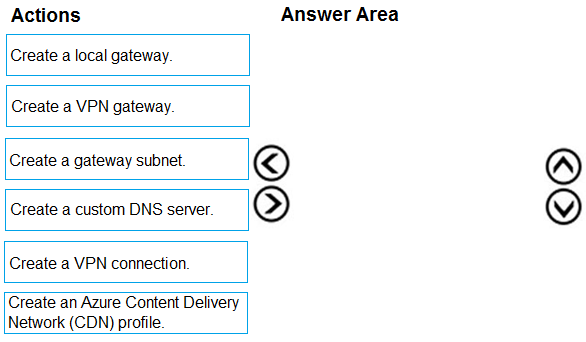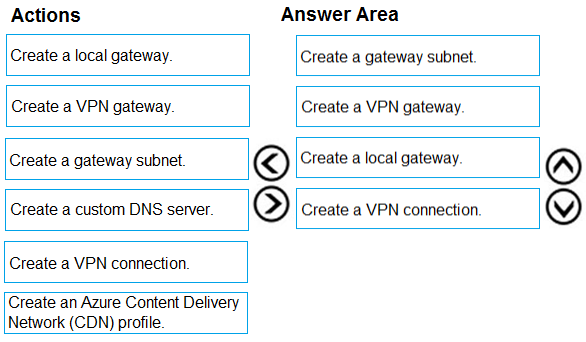

DRAG DROP -
You have an on-premises network that you plan to connect to Azure by using a site-so-site VPN.
In Azure, you have an Azure virtual network named VNet1 that uses an address space of 10.0.0.0/16 VNet1 contains a subnet named Subnet1 that uses an address space of 10.0.0.0/24.
You need to create a site-to-site VPN to Azure.
Which four actions should you perform in sequence? To answer, move the appropriate actions from the list of actions to the answer area and arrange them in the correct order.
NOTE: More than one order of answer choice is correct. You will receive credit for any of the correct orders you select.
Select and Place:

ZUMY
Highly Voted 4 years, 4 months agoErenYeager
4 years, 2 months agoLeomHD
3 years, 8 months agomagichappens
3 years, 3 months agoShaulS
3 years, 7 months agopappkarcsiii
3 years, 4 months agomlantonis
Highly Voted 4 years, 1 month agoFryether1
10 months, 3 weeks agoknowakuk
6 months, 2 weeks agojeru81
1 year, 4 months ago090200f
1 year agocastleapp
Most Recent 6 months, 1 week ago[Removed]
9 months, 2 weeks agotashakori
1 year, 3 months agoJosete1106
1 year, 11 months agoCyberKelev
2 years, 4 months agoCyberKelev
2 years, 4 months agoklexams
2 years, 8 months agoSeb
2 years, 9 months agolibran
2 years, 10 months agoEmnCours
2 years, 10 months agoLazylinux
3 years agocloudera
3 years, 1 month agocloudera
3 years, 1 month agobenvdw
3 years, 3 months agoFabioVi
3 years, 5 months agokhengoolman
3 years, 8 months ago